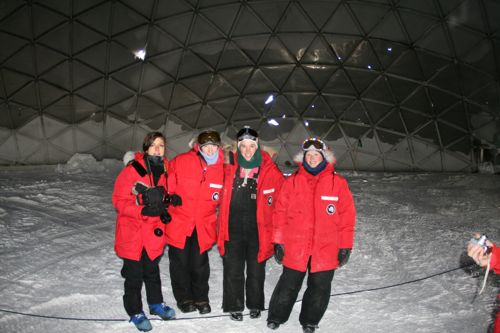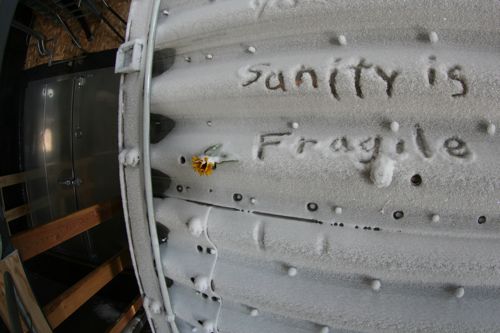Today's my last day at the Pole. I'll hop on a C-130 at around noon and fly back to McMurdo. Last night, the South Pole Telescope hosted a "ladies night" event with music and dancing and tours of the telescope - that was a lot of fun, a nice celebration to bring my month-long visit to the South Pole to a close.
This morning, at about 4 am, a crane prepared to lift the top of the old Dome station as the first stages of demolition. This is the end of a long and storied era of the South Pole Station!
The first South Pole Station (the Dome was the second station) was built in 1956-1957, as part of the International Geophysical Year. It was used continuously, even in the winters housing around 20 people for the cold dark months and maybe twice that number of people during the summer.
 An outside view of the Dome. Originally the entrance had a fancier tunnel but that has been dismantled already. The Dome is a geodesic dome built of aluminum triangles, 50 meters across and 16 meters high.
An outside view of the Dome. Originally the entrance had a fancier tunnel but that has been dismantled already. The Dome is a geodesic dome built of aluminum triangles, 50 meters across and 16 meters high.
The Dome was built in 1975 as a hollow geodesic dome, 50 meters in diameter and 16 meters tall. It housed smaller buildings inside it, that resembled train boxcars. These buildings were the entire station - housing, kitchen, research areas, etc. As time went on, more buildings were added around the Dome to house scientific research and an expanding population, but the Dome was still the central hub of the South Pole Station. It was designed to operate for 25 years.
 The arches were built to house power plants, heavy equipment, fuel, machinery, etc. I believe they will continue to provide service for the current elevated station, even as the Dome is being decommissioned.
The arches were built to house power plants, heavy equipment, fuel, machinery, etc. I believe they will continue to provide service for the current elevated station, even as the Dome is being decommissioned.
Unfortunately, the design of the Dome (and the original pole station) allowed snow to blow up against the station and cause drifting. Without constant maintenance, the Dome would be quickly buried (in fact, the original station is now completely buried, and IceCube found out the hard way when they tried to drill through the ice and instead hit the old station!).
Snow drift issues, and the increasing population at the South Pole during the summers, encouraged the construction of an entirely new structure - the "elevated station" which is the current Amundsen-Scott South Pole Station. It is elevated above the surface to allow the wind to blow the snow right on through, preventing drifts from building up, and can be jacked up higher as the snow accumulates each year. The new station was opened in 2003, and the Dome became used for things like storing the station's food supplies and other equipment.
 Various tunnels linked the Dome, the Arches, the Ice Tunnels, and the elevated station. Lots of pipes run through here, mostly transporting water and wastewater to and fro.
Various tunnels linked the Dome, the Arches, the Ice Tunnels, and the elevated station. Lots of pipes run through here, mostly transporting water and wastewater to and fro.
 The SkyLab tower housed early astronomy projects. Eventually the top floor was turned into a music room, away from the housing inside the dome, so people could rock out at full volume without disturbing anyone.
The SkyLab tower housed early astronomy projects. Eventually the top floor was turned into a music room, away from the housing inside the dome, so people could rock out at full volume without disturbing anyone.
So now, 34 years later, the Dome is being decommissioned, demolished, and shipped in bits and pieces back to the US. Many people at the Pole are sad to see it go - it is a very iconic structure, and a lot of people spent a lot of hours living and working there. By the end of this season, it will most likely just be a large hole in the ice, quickly filling up with freshly drifting snow!
 This weekend was the last time the Dome would be open for visiting. Pictured from left to right: Delia Tosi (IceCube), Karen Andeen (IceCube), Abby Criter (SPT), and Liz George (SPT).
This weekend was the last time the Dome would be open for visiting. Pictured from left to right: Delia Tosi (IceCube), Karen Andeen (IceCube), Abby Criter (SPT), and Liz George (SPT).
 When in operation, the Dome protected small buildings, some two stories tall, that served as research stations, operations, and housing.
When in operation, the Dome protected small buildings, some two stories tall, that served as research stations, operations, and housing.
 The official start of Dome deconstruction. You can see the missing section on the top, which was removed by a crane on the morning of Dec. 18, 2009.
The official start of Dome deconstruction. You can see the missing section on the top, which was removed by a crane on the morning of Dec. 18, 2009.
In an entirely unrelated event, I've reached the official end of my beard-growing experiment. It is now about 4 weeks since I last shaved at McMurdo Station when I first set foot on the continent, and now it's time to check out the data. There are two things that should be done with this data:
Use a proper method for determining my average beard growth rate here at the South Pole, and compare it to the average beard growth rate in California. I would suggest checking out the analyses done by Mrs. Ratliff's students, you can find that on the Ask The Team forum.
Then, if it's been determined that my beard growth rate is significantly faster or slower, then I think it would be important to try to figure out why there would be a difference. Perhaps checking in with biology teachers might help spark some ideas on if or why facial hair would grow differently in extreme environments like the South Pole. OK, here is the data. I was really busy so didn't always get around to measuring, so there are not as many data points as before! but a quick inspection already makes it look like there might be a difference! If you figure it out, publish your results on the Ask the Team page.
11/22: 0, 0, 0
12/3: 5.5, 5.2, 6.0
12/6: 7.0, 7.0, 6.0, 5.5
12/8: 7.5, 7.3, 7.5
12/10: 8.0, 8.0, 8.5
12/15: 8.5, 9.5, 10
12/18: 9.0, 9.8, 10 I am now officially on my way home including a one-night stopover at McMurdo Station, and then another week in New Zealand. I will keep posting on other interesting things I see. l also have another video I need to edit and post as a follow-up to the Ice Cream experiment, so stay tuned!
 While walking through the upright aluminum cylinder that leads to the Elevated Station (unofficially known as the Beer Can), I came upon this message and a little flower frozen into the hoarfrost on the inside walls.
While walking through the upright aluminum cylinder that leads to the Elevated Station (unofficially known as the Beer Can), I came upon this message and a little flower frozen into the hoarfrost on the inside walls.
